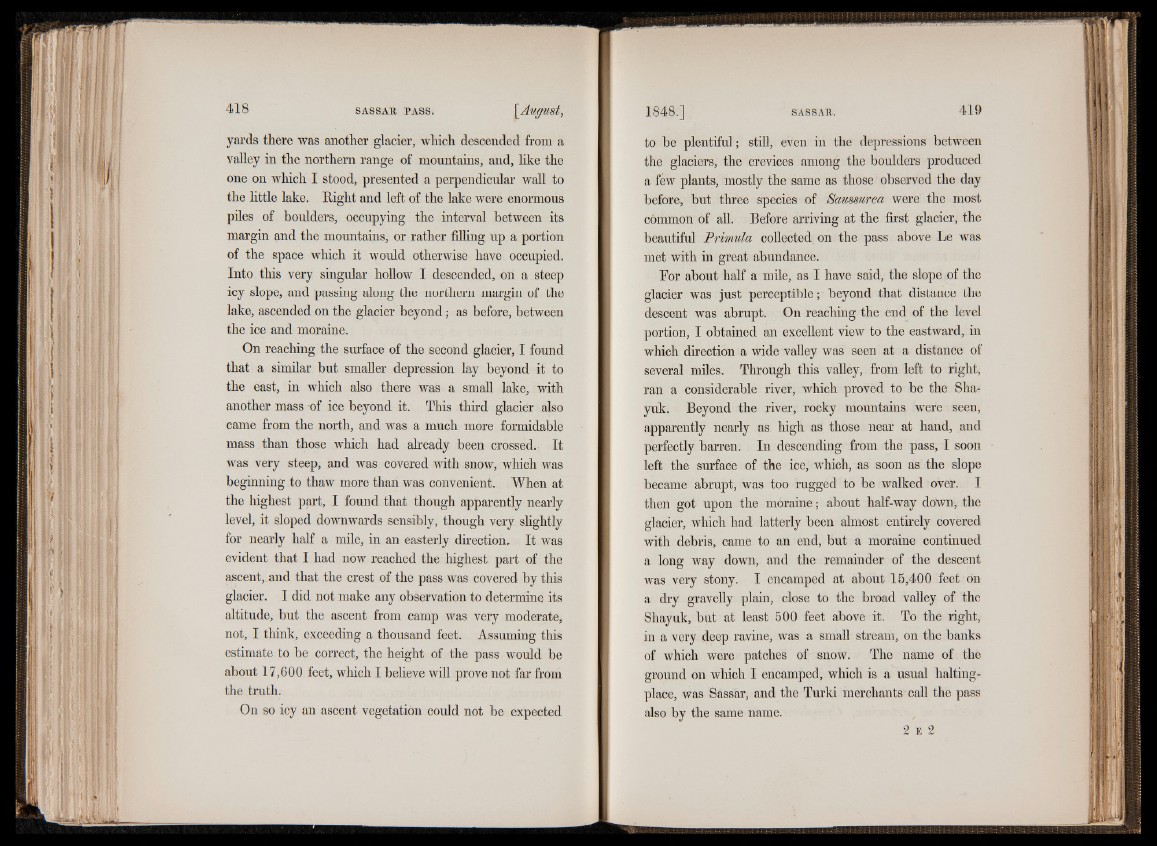
yards there was another glacier, which descended from a
valley in the northern range of mountains, and, like the
one on which I stood, presented a perpendicular wall to
the little lake. Right and left of the lake were enormous
piles of boulders, occupying the interval between its
margin and the mountains, or rather filling up a portion
of the space which it would otherwise have occupied.
Into this very singular hollow I descended, on a steep
icy slope, and passing along the northern margin of the
lake, ascended on the glacier beyond; as before, between
the ice and moraine.
On reaching the surface of the second glacier, I found
that a similar but smaller depression lay beyond it to
the east, in which also there was a small lake, with
another mass of ice beyond it. This third glacier also
came from the north, and was a much more formidable
mass than those which had already been crossed. It
was very steep, and was covered with snow, which was
beginning to thaw more than was convenient. When at
the highest part, I found that though apparently nearly
level, it sloped downwards sensibly, though very slightly
for nearly half a mile, in an easterly direction. It was
evident that I had now reached the highest part of the
ascent, and that the crest of the pass was covered by this
glacier. I did not make any observation to determine its
altitude, but the ascent from camp was very moderate,
not, I think, exceeding a thousand feet. Assuming this
estimate to be correct, the height of the pass would be
about 17,600 feet, which I believe will prove not far from
the truth.
On so icy an ascent vegetation could not be expected
to be plentiful; still, even in the depressions between
the glaciers, the crevices among the boulders produced
a few plants, mostly the same as those observed the day
before, but three species of Saussurea were the most
common of all. Before arriving at the first glacier, the
beautiful Primula collected on the pass above Le was
met with in great abundance.
For about half a mile, as I have said, the slope of the
glacier was just perceptible; beyond that distance the
descent was abrupt. On reaching the end of the level
portion, I obtained an excellent view to the eastward, in
which direction a wide valley was seen at a distance of
several miles. Through this valley, from left to right,
ran a considerable river, which proved to be the Sha-
yuk. Beyond the river, rocky mountains were seen,
apparently nearly as high as those near at hand, and
perfectly barren. In descending from the pass, I soon
left the surface of the ice, which, as soon as the slope
became abrupt, was too rugged to be walked over. I
then got upon the moraine; about half-way down, the
glacier, which had latterly been almost entirely covered
with debris, came to an end, but a moraine continued
a long way down, and the remainder of the descent
was very stony. I encamped at about 15,400 feet on
a dry gravelly plain, close to the broad valley of the
Shayuk, but at least 500 feet above it. To the right,
in a very deep ravine, was a small stream, on the banks
of which were patches of snow. The name of the
ground on which I encamped, which is a usual halting-
place, was Sassar, and the Turki merchants call the pass
also by the same name.
2 e 2